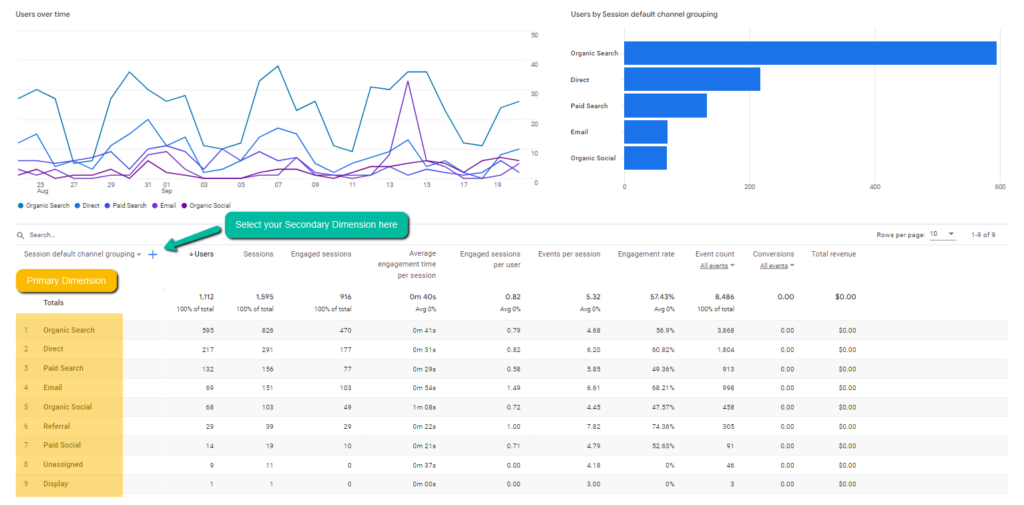Step-by-Step Guide: Leveraging Secondary Dimension in Google Analytics
Step-by-Step Guide: Leveraging Secondary Dimension in Google Analytics
Blog Article
Enhance Your Information Evaluation Making Use Of Secondary Measurement in Google Analytics
Checking out the capabilities of second dimensions in Google Analytics opens a world of opportunities for refining data analysis. By layering additional measurements onto main data collections, a more elaborate story arises, dropping light on individual communications and efficiency indications.
Comprehending Secondary Dimensions
In the world of information analysis, a critical element to understanding is the idea of additional dimensions and their value in removing much deeper insights from Google Analytics reports. Secondary measurements in Google Analytics refer to added parameters that can be included in the main dimension, permitting an extra comprehensive evaluation of data. By including second dimensions, experts can segment and filter data to uncover patterns, fads, and relationships that could not appear when looking at the information in its entirety. These secondary measurements can give context and an extra comprehensive understanding of user habits, web traffic resources, and various other essential metrics tracked by Google Analytics.

Advantages of Making Use Of Second Dimensions
When analyzing information in Google Analytics, the application of additional measurements provides indispensable understandings into customer actions and performance metrics. By including a second measurement to your key data, you can dig much deeper right into the features of your web site site visitors and their interactions. One of the vital benefits of utilizing second measurements is the capacity to segment and compare data more effectively. This segmentation allows you to understand how different variables, such as demographics or website traffic resources, influence user habits and conversions (Secondary Dimension in Google Analytics).
Furthermore, secondary measurements help in determining patterns and connections that may not be instantly noticeable when considering the information in isolation. This deeper level of evaluation can uncover useful info that can lead advertising and marketing methods, web site optimization, and general organization decisions. In addition, second dimensions improve the context of your main data, supplying a much more comprehensive view of user engagement and efficiency metrics. In general, using additional measurements in Google Analytics can substantially boost the depth and top quality of your information analysis, bring about even more informed decision-making and enhanced end results.
Exactly How to Add Second Measurements
By integrating second dimensions in Google Analytics, users can get much deeper insights right into their information evaluation process, enabling for even more comprehensive examination of individual actions and efficiency metrics. Including additional dimensions is an uncomplicated procedure that can substantially improve the depth of evaluation. When in the report, locate the "Additional measurement" tab above the data table.
Analyzing Data With Additional Measurements
Making use of secondary dimensions in data analysis gives a much more thorough understanding of user actions and efficiency metrics. By adding an additional dimension to your main data set in Google Analytics, you can delve much deeper right into the attributes of your site site visitors and their interactions. For example, incorporating the main dimension of 'source/medium' with the additional dimension of 'touchdown web page' can reveal which specific pages are bring in website traffic from various sources, helping you maximize these pages for far better engagement.

Basically, evaluating information with additional dimensions equips you to get important understandings right into user behavior, identify fads, and make notified decisions to enhance the performance of your electronic residential properties.
Ideal Practices for Additional Measurements
In information analysis, including additional dimensions effectively can significantly enhance the deepness of understandings originated from metrics and individual actions patterns. When making use of secondary dimensions in Google Analytics or any various other analytical tool, it is crucial to comply with finest practices to ensure the precision and importance of the information analysis.
One trick finest practice is to thoroughly select additional measurements that complement the primary measurement being analyzed. Choosing second dimensions that offer extra context or additional division can supply an extra check over here detailed understanding of the information. It is additionally important to prevent overcomplicating the analysis by consisting of way too many secondary measurements, which may bring about confusion or dilution of insights.
Furthermore, it is directory a good idea to explore different combinations of main and additional dimensions to uncover brand-new relationships and patterns. Consistently evaluating and improving the choice of second dimensions based upon the details objectives of the evaluation can bring about even more actionable understandings. By complying with these ideal practices, data analysts can take advantage of additional measurements properly to boost the general information analysis process and decision-making abilities.

Verdict
Finally, integrating secondary dimensions in Google Analytics is vital for a detailed data evaluation method. By leveraging additional measurements alongside main ones, marketers and experts can discover useful understandings and relationships that can educate decision-making and maximize digital marketing approaches. Recognizing how to efficiently use second dimensions and adhering to finest practices will certainly allow professionals to extract meaningful data and enhance their overall performance metrics.
Secondary dimensions in Google Analytics refer to added specifications that can be included to the primary dimension, allowing for a more thorough analysis of data. By incorporating second measurements, analysts can section and filter information to reveal patterns, patterns, and correlations that might not be obvious when looking at the information as a whole. Combining the primary dimension of 'source/medium' with the click here for more secondary measurement of 'touchdown page' can expose which certain pages are bring in website traffic from different resources, helping you maximize these pages for better interaction.
One trick finest practice is to carefully select additional dimensions that match the main dimension being analyzed. By complying with these finest methods, data experts can utilize second dimensions effectively to boost the overall information analysis procedure and decision-making abilities.
Report this page